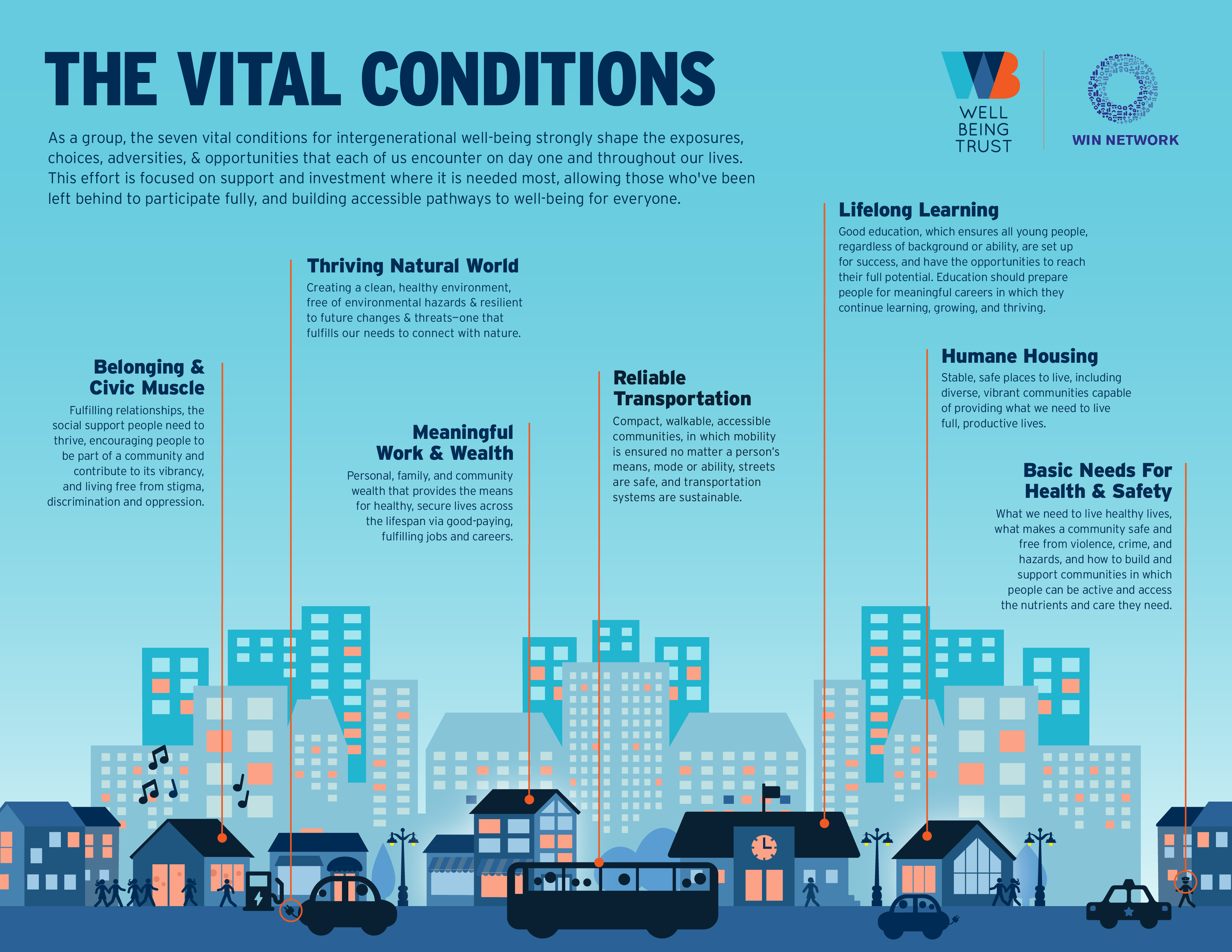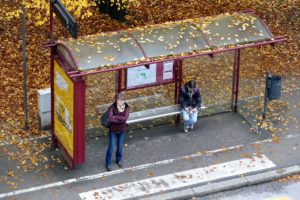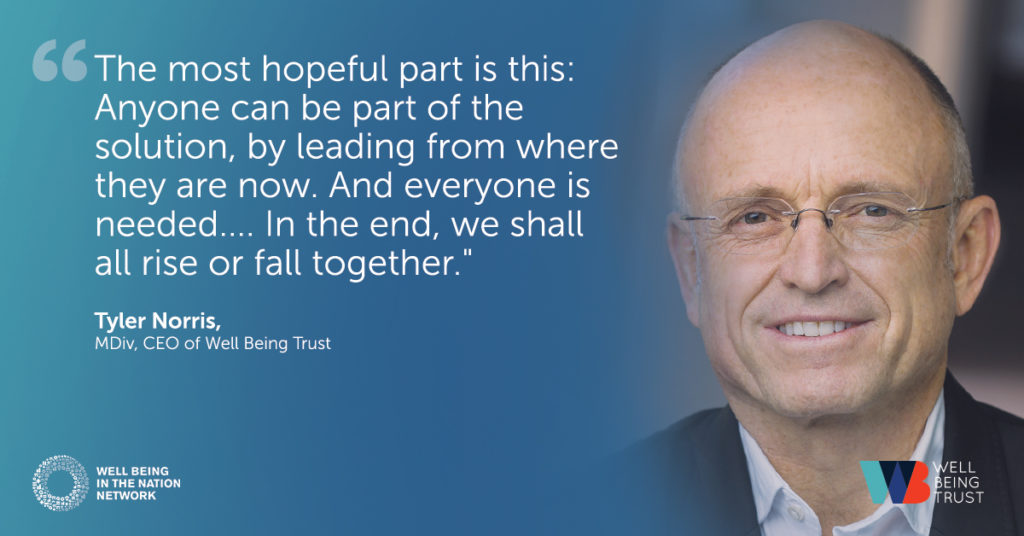By Tyler Norris
To increase well-being for all in America, we need to reclaim our communities, not just ourselves.
We all know that by reducing our stress, increasing social connections, eating healthier and being more active we can enhance our mental and physical health. But our individual health and well-being are also directly shaped by the vitality and well-being of the places where we live. What most of us need to truly flourish are communities that make the healthier choices the easier choices. And places that create a welcoming experience of belonging for everyone, while offering meaningful opportunities to learn, express our sense of purpose, and serve others.
Across the nation, communities are convening diverse groups of residents to build trust across lines that too-oft divide and taking shared actions as “stewards of the future” to improve health and well-being for all. In so doing, they are bridging differences of politics, income, race/ethnicity, gender, geography, sector, age and else—to embrace common-sense actions that can make a substantive difference in people’s lives.
The Well Being in the Nation (WIN) Network—a new collaboration focused on creating the conditions for intergenerational well-being—looks to these communities as pacesetters in confronting challenges and creating the civic will to take pragmatic actions that enrich health for everyone. By joining forces to reverse negative trends in the diseases and deaths of despair, the WIN partners are lifting up what works and are building a foundation upon which lasting legacies of well-being can prosper for years to come. At the heart of this mission, are seven “vital conditions” that are essential for the sustained well-being of people and place.

 1. Basic needs for health and safety
1. Basic needs for health and safety
Clean air, water and food, as well as an environment free from physical, social and emotional harm, are vital to healthy living. Legacies of intergenerational violence, racism, poverty and inaccessible healthcare, however, challenge the equitable provision of these needs. Forty-two million people lack steady access to sufficient food — and 13 million of them are children. Breaking these cycles of harm, promoting safe and healthy habits, and transforming the healthcare industry to be cost-inclusive and trauma-informed are all necessary steps in creating a sustainable base for long-lasting health.
2. Reliable transportation
“Car-first” culture — prioritizing automobiles over public and active transit options —has generated many painful legacies, including road traffic, pollution, declining physical activity and injuries and fatalities. About 5,000 people are killed by cars while walking each year. In addition to poor land use that’s given rise to suburban sprawl and vehicle emissions exacerbating climate change, underinvestment in public transportation has isolated low-income communities and communities of color. They rely on transportation to access healthcare, work and education — all of which are necessary to lasting well-being. Creating transit-oriented communities that prioritize people over cars, ensuring safe and accessible streets for all and promoting active transportation are important steps to reshaping the transportation system and recreating a better legacy of health.
3. Lifelong learning
A quality K-12 education is not a privilege — it is a necessary right to ensure the greatest potential for continuing health, social mobility and well-being among future generations. Legacies of segregation and discrimination in school systems, as well as inadequate funding to schools serving predominantly low-income students and students of color, are obstacles that prevent communities and families from setting children on the path toward productive futures. To create a lasting legacy of learning for every student, we must fund schools sufficiently, dismantle the school-to-prison pipeline, eliminate unfair discipline practices, and tackle crushing student debt for higher education.
4. Thriving natural world
Clean air, clean water, clean land and well-functioning ecosystems are essential to human well-being. They protect us from premature death, cancer, and developmental disabilities and keep the food chain intact. To promote healthy environments and communities, we must transition to a green economy, emphasize reliable mass transit systems, move to compact development patterns, deploy regenerative agricultural practices, and address climate change at every level, from the most local to the most global.
5. Meaningful work and wealth
Good-paying, fulfilling jobs and careers enable economic and social mobility, as well as financial security that extends across the lifespan. Meaningful work lifts up entire families and communities. Inequality has grown over the past several decades, and deepening socioeconomic divides have limited opportunities for mobility—these disparities weren’t always so stark. Many children and families have, as a result, endured hardship across generations. Children’s prospects of earning more than their parents have fallen by 40% over the past half century, from 90 percent to 50 percent. To provide people with the means for healthy, secure lives, we must provide a job guarantee and unconditional basic income, strengthen labor unions, promote entrepreneurship, create opportunities for cooperative and employee ownership, reduce student debt, and encourage saving.
6. Humane housing
To thrive, people need secure, consistent places to live. They need safe homes and neighborhoods that don’t make them sick, and vibrant communities that provide what they need for their lives and livelihoods. Decreasing housing affordability and increasing homelessness have put the health and well-being of many people at risk. We need to seek permanent solutions to affordable housing shortages, eliminate homelessness, promote community design that connects neighborhoods with resources, explore community-based approaches to reducing indoor air pollution, and expand accessible housing that enables seniors to age in place.
7. Belonging and civic muscle
People are healthier when they are connected to others. We all need social support from friends, family and other networks to help navigate life’s stresses, be mentally and emotionally well, and stay on track with healthy behaviors. When communities have a sense of cohesion, people work together to boost the conditions that will make them all healthier and more well. We need to take collective action against structural racism and hate, invest in institutions that support resident participation and collaboration, create more public spaces, and commit to reconnecting young people who have fallen through the cracks to school and work.
Reclaiming our future, now!
In the face of declining U.S. lifespans, our best hope for a thriving future lay in reclaiming our communities’ well-being, alongside our own. To ensure everyone benefits, not just those of privilege, we must remove barriers to participation and opportunity for low-income persons, people of color, indigenous peoples, and others who are often systemically marginalized—and as such, experience the worst health outcomes. But we cannot stop there. We must focus on investing where it is needed most, allowing those who have been left behind to participate fully, building accessible pathways to well-being and ensuring a path forward for everyone.
Transforming our communities by assuring the vital conditions for intergenerational well-being provides a clear direction for achieving an equitable and sustainable legacy that is worthy of our lives and our democracy.

Tyler Norris, MDiv, is CEO of Well Being Trust. From 1990-1995, he the led Civic Assistance Program at the National Civic League.



